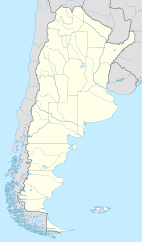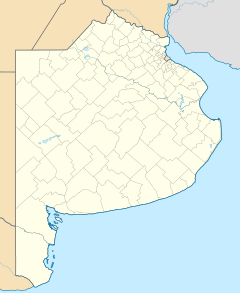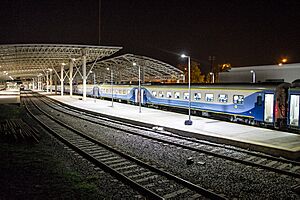Mar del Plata facts for kids
Quick facts for kids
Mar del Plata
|
||
|---|---|---|

From the top, left to right: city skyline, Torre Tanque, fishing boats in the port, Saint Michael chalet, Castagnino Museum, Sea Lion Monument, Torreón del Monje, Mar del Plata Cathedral, and a panoramic view from Edén Palace featuring the Casino Central and the NH Gran Hotel Provincial.
|
||
|
||
| Nickname(s):
La Feliz (The Happy [One]), Mardel, La Perla del Atlántico (The Pearl of the Atlantic)
|
||
| Country | ||
| Province | ||
| Partido | General Pueyrredón | |
| Founded | February 10, 1874 | |
| Area | ||
| • City | 79.48 km2 (30.69 sq mi) | |
| Elevation | 38 m (125 ft) | |
| Population
(2022 census)
|
||
| • Urban | 682,605 | |
| • Demonym | Marplatense | |
| Time zone | UTC−3 (ART) | |
| Postal code |
7600
|
|
| Phone code | +54 223 | |
| Climate | Cfb | |
Mar del Plata is a lively city located on the coast of the Atlantic Ocean in Buenos Aires Province, Argentina. It is the main city of the General Pueyrredón district. Mar del Plata is the second largest city in Buenos Aires Province.
The name "Mar del Plata" means "sea of the Rio de la Plata basin" or "sea next to the River Plate region." It is one of Argentina's most important fishing ports and the biggest seaside beach resort. In 2022, its population was 682,605, making it the 5th largest city in Argentina.
Contents
- What Makes Mar del Plata Special?
- Getting Around Mar del Plata
- A Look Back at Mar del Plata's Past
- Culture and Fun in Mar del Plata
- Famous People from Mar del Plata
- Mar del Plata's Unique Buildings
- Weather in Mar del Plata
- Learning in Mar del Plata
- Sports in Mar del Plata
- Mar del Plata Around the World
- Images for kids
- See also
What Makes Mar del Plata Special?
A Hub for Tourism
Mar del Plata is a very popular place for tourists in Argentina. Millions of people visit the city every year, especially in summer. It has many hotels, restaurants, casinos, and theaters. The city is also a big sports center. It has a large stadium used for big events like the 1978 FIFA World Cup and the 1995 Pan American Games. There are also five golf courses and other sports facilities.
Industries and Jobs
Mar del Plata is a major fishing port. Many businesses here focus on processing fish. There are also shipyards that build and repair boats.
The city has other industries too. These include making textiles (like clothes), food products, and polymers (plastics). Companies here also make packaging machines, and some even export their designs to other countries.
In recent years, Mar del Plata has become a center for technology. Companies here make personal computers, tablet computers, smartphones, and action-cams. The software industry has also grown a lot, with many new companies starting up. Some of these companies have even opened offices in other countries.
Since the 2000s, a local company has been building equipment for the oil industry. They have customers in many countries around the world.
Local Products
Southwest of the city, there are quarries where quartzite stone is mined. This stone is used in construction. The rural areas around Mar del Plata have many farms that grow vegetables.
In 2012, Mar del Plata started making its own wine! A company from Mendoza province began producing wine from vineyards near Chapadmalal beach. Now, the local winery is also a tourist attraction. The city has also seen a boom in microbreweries, making up a large part of Argentina's craft beer production.
Getting Around Mar del Plata
Mar del Plata has its own airport, Astor Piazzolla International Airport. You can fly from here to Buenos Aires and other parts of Argentina.
Major highways connect Mar del Plata to other cities. Highway 2 links it to Buenos Aires, and Route 11 runs along the coast.
The city also has a modern bus and train station. You can take a train to Buenos Aires or a bus to many cities across Argentina.
A Look Back at Mar del Plata's Past
Early Days
Long ago, the area was home to the Günuna Kena nomads, also known as northern Tehuelches. Later, the Mapuche culture had a strong influence on them.
European explorers first arrived in the late 1500s. Sir Francis Drake explored the coast, and Don Juan de Garay explored by land. In 1742, a group of English sailors survived a shipwreck nearby and lived with the Tehuelches for a while.
The first attempt to settle the area by the Jesuit Order in 1751 was not successful.
Founding the City
In 1857, a Portuguese businessman built a factory for salted meat here, but it didn't last long.
The city of Mar del Plata was officially founded on February 10, 1874, by Patricio Peralta Ramos. He bought the old factory and the land around it. Soon after, a rancher named Pedro Luro bought some land for farming.
Growth and Development
The railway line from Buenos Aires reached Mar del Plata in 1886. This made it much easier for people to visit. Wealthy people from Buenos Aires started coming here for vacations, and the first hotels opened. They built a French-style resort. In 1907, Mar del Plata was officially declared a city.
In the early 1900s, many new immigrants from Europe moved to Mar del Plata. They helped change the local government and brought in social reforms. The main port was also built and opened in 1916.
In 1932, National Route 2 was finished, connecting Mar del Plata directly to Buenos Aires. Before this, the journey by car took almost two days! The famous seaside Casino complex, designed by architect Alejandro Bustillo, opened in 1939.
Modern Times
After 1946, many more people started visiting Mar del Plata. This was due to new social programs and the growth of the middle class. This led to a huge increase in the city's economy.
From the 1950s to the 1970s, there was a big construction boom. Many people moved to Mar del Plata from other parts of Argentina.
In the early 2000s, the city's economy recovered quickly. In November 2005, Mar del Plata hosted the 4th Summit of the Americas, a big meeting of leaders from different countries.
Culture and Fun in Mar del Plata
Mar del Plata is a popular place for conventions and events in Argentina. During the summer, you can find over fifty different plays and shows.
Religious Sites
For those interested in religious tourism, Mar del Plata has an interesting "interreligious circuit." This includes the Cathedral, the Schoenstatt Sanctuary, and a replica of the Lourdes Grotto. You can also visit the Russian Orthodox Church, the Sunni Mosque, and the Gabriel Temple of the Jewish community.
Exciting Shows and Festivals
- The Mar del Plata International Film Festival is the only "A class" film festival in Latin America.
- The Fiesta Nacional del Mar (National Sea Festival) happens in December. A "Sea Queen" is chosen to officially start the summer season.
- The Premios Estrella de Mar (Sea Star Awards) celebrate the best plays and shows of the season.
- The Fiesta Nacional de los Pescadores (National Fishermen's Festival) is a colorful event that shows off the traditions and food of the city's sailors.
- Mar del Plata has also hosted many big sports events, like the 1995 Pan American Games and parts of the 1978 FIFA World Cup.
- Since 1987, the city has hosted the Mar del Plata Marathon every December.
- The International Mathematical Olympiad was held here in 1997 and 2012.
- The Festival Internacional de Poesia del Atlantico (International Poetry Festival of the Atlantic) brings poets from many countries together.
The local government also supports a Symphonic Orchestra.
Nightlife and Museums
Mar del Plata has many clubs and pubs, especially in the Escollera Norte area and on Constitution Avenue.
The city has several interesting museums:
- The Juan Carlos Castagnino Municipal Museum of Art.
- The Museum of the Port of Mar del Plata Cleto Ciocchini.
- The Museum of Contemporary Art MAR.
- The Museum of Natural Science Lorenzo Scaglia, which focuses on ancient animals from the region.
- Villa Victoria, a beautiful old wooden house that was once the home of writer Victoria Ocampo. Now it hosts art shows and classical music concerts.
- The Submarine Force Museum, located near the Mar del Plata Naval Base.
Famous People from Mar del Plata
Many talented people have come from Mar del Plata:
- Gabriel Amato (born 1970), a former international soccer player.
- Inés Arrondo (born 1977), a field hockey player who won Olympic medals.
- Héctor Babenco (1946–2016), a movie director who grew up in Mar del Plata.
- Erica Vanessa Bibbó (1985), the first female commander of a naval unit in the Argentine navy.
- Amado Boudou (born 1962), a former Vice President of Argentina.
- Alberto Bruzzone (1907–1994), a famous painter.
- Germán Burgos (born 1969), a former soccer goalkeeper.
- Macarena Achaga (born 1992), an actress, model, and singer.
- Juan Carlos Castagnino (1908-1972), a well-known painter.

- Juan Curuchet (born 1965), a cyclist who won a gold medal at the 2008 Summer Olympics.
- Jorge Lanata (born 1960), a famous journalist and writer.
- Ástor Piazzolla (1921-1992), a world-famous composer and musician.
- Ricardo Piglia (1941–2017), a respected writer.
- Alfonsina Storni (1892-1938), a famous poet.
- Guillermo Vilas (1952), a top international tennis player.
- Emiliano Martínez (1992), a football player for Aston Villa F.C..
- Milton Martinez (1991), a professional skateboarder.
Mar del Plata's Unique Buildings
In the early 1900s, wealthy tourists from Buenos Aires built many European-style homes in Mar del Plata. This gave the city the nickname "Argentine Biarritz," like the famous French resort.
Later, local builders created a unique style called the Mar del Plata style. These homes were often small chalets with stone fronts, sloped roofs, and front porches. This style gives Mar del Plata a special look compared to other Argentine cities. Even though many large apartment buildings were built later, these charming chalets are still a big part of the city's character.
Weather in Mar del Plata
Mar del Plata has an oceanic climate, which means it has mild and humid summers and cool winters. The average temperature in January (summer) is around 20.4°C (68.7°F). In July (winter), it's about 7.5°C (45.5°F).
Sometimes, cold air from Antarctica can make temperatures drop below freezing in winter. Strong winds from the southeast, called Sudestada, can bring coastal showers and rough seas.
Summer temperatures usually average around 26°C (79°F), but they can sometimes reach 30°C to 35°C (86°F to 95°F). Even in summer, nights can be cool, sometimes falling below 10°C (50°F).
In winter, daytime temperatures are usually around 13°C (55°F), and nights are around 4°C (39°F). It can sometimes get much colder, with temperatures falling below 0°C (32°F) at night.
Snowfall is not very common, but it does happen every few years. There was snow on the ground in 1975, 1991, 1994, 1997, 2004, 2010, and 2015.
The wettest months are from October to April, especially in summer. The city gets about 926.1 mm (36.5 inches) of rain each year.
Learning in Mar del Plata
The city has many schools and universities, both public and private.
Universities and Art Schools
- Universidad Nacional de Mar del Plata (UNMdP): A public university with many different study programs.
- Escuela de Artes Visuales Martín A Malharro: A higher education school for visual arts. It offers degrees in Graphic Design, Photography, Illustration, and Film.
- Polivalente de Arte (Escuela de Educación Secundaria Especializada en Arte Nº 1): A secondary school that also teaches art, music, or dance.
There are also two music conservatories (for classical and popular music), a vocational art school, and a municipal school for classical and modern dance.
Sports in Mar del Plata
Mar del Plata loves sports! The most popular football (soccer) teams are Aldosivi, Alvarado, and Kimberley.
In basketball, Peñarol and Quilmes de Mar del Plata are the top teams. Peñarol has won many national and international tournaments. Mar del Plata hosted the 2011 FIBA Americas Championship, where Argentina's national basketball team won the gold medal. All games were played at the 8,000-seat Polideportivo Islas Malvinas.
The city has also hosted many other major sports events:
- Six matches of the 1978 FIFA World Cup at the Estadio José María Minella.
- Six games of the 2002 FIVB Volleyball Men's World Championship.
- The 1995 Pan American Games.
- The 2001 Rugby World Cup Sevens.
- The 2nd Parapan American Games in 2003, with 1,500 athletes from 28 countries.
- The 20th World Transplant Games in 2015.
- The starting point for the 2012 Dakar Rally.
Mar del Plata Around the World
Sister Cities
Mar del Plata has special connections with other cities around the world, called "twin towns" or "sister cities." These connections help promote cultural exchange and friendship.
 Acireale, Italy
Acireale, Italy Viña del Mar, Chile
Viña del Mar, Chile Tianjin, China
Tianjin, China Havana, Cuba
Havana, Cuba A Coruña, Spain
A Coruña, Spain Biarritz, France
Biarritz, France Bari, Italy
Bari, Italy Ischia, Campania, Italy
Ischia, Campania, Italy San Benedetto del Tronto, Italy
San Benedetto del Tronto, Italy Agadir, Morocco
Agadir, Morocco Vigan, Philippines
Vigan, Philippines Saint Petersburg, Russia
Saint Petersburg, Russia Fort Lauderdale, USA
Fort Lauderdale, USA
Images for kids
-
Villa Victoria, the former home of Victoria Ocampo
See also
 In Spanish: Mar del Plata para niños
In Spanish: Mar del Plata para niños





























